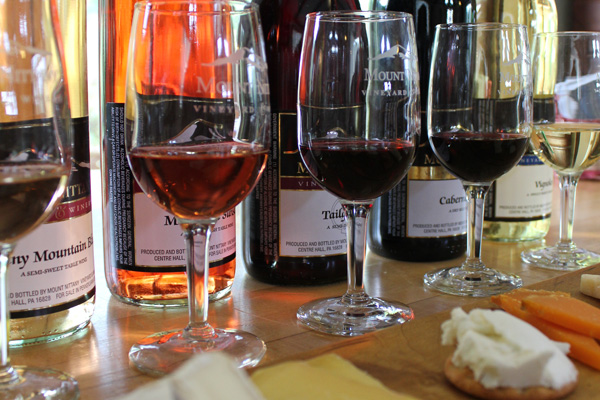-

Erin Donahue -

Christina Barkanic -

Brittany Trott -

Emily Wiley -

Jessica Reilley -

Chris Raines -

Will Nichols -

Emily Reddy -

Michele Marchetti -

Michele Frank -

James Gherardi -

Kit Henshaw -

Christina and Erin -

Kim Tait -

Erin McKinney -

Steve Spanelli -

Sam Komlenic -

Katherine Taylor Grofic -

James Eisenstein -

Jamie Oberdick -

Anna Lombardo -

LacCreta Holland -

Tony Ricci -

Local Food Journey -

Laura Young -

Kristin Camplese -

Harrison's Fresh + Local -

Danielle Matalonis -

Kristine A. -

Linda Weaver -

Naomi Elle Schwartz -

Dana Stuchul -

Cara McShane -

Brittany Smith -

Jessica Illuzzi - Frosty
-

Jessica Paholsky -

James Sechrengost -

Brad Yeckley -

Maya Althouse -

Jordan Reabold -

Kim Chase -

Maria Bryant - Alexandrea Scott
Wine and Cheese Fundamentals
Posted by Linda Weaver on 07/13, 2012 at 12:26 PM

Photo Credit Mount Nittany Vineyard and Winery.
Mount Nittany Vineyard and Winery held its second (sold-out!) wine and cheese pairing event, “Wine and Cheese Fundamentals,” on June 30th. The event was led by Jamie Ryan, a central Pennsylvania native and Penn State graduate. Jamie is a wine consultant with a distinguished fifteen year career in wine sales, purchasing, and education and brings with her a comprehensive knowledge of the wine industry from vineyard to the table. The class enjoyed a casual evening of guided wine and cheese pairings and an interactive discussion of the connection between them. Here, Jamie shares with us her insights on the topic:
“In wine and cheese pairing, the fundamental goal is balance. The flavors found in both the wine and the cheese should be balanced and neither should overpower the other. A well matched pairing should enhance the existing elements of each and ultimately bring out new flavors that are not detected in the wine or cheese when they stand alone. Some basic guidelines are:
Pair Salty and Sweet - A salty cheese pairs well with a sweet dessert wine. As we all love salty sweet desserts, salted caramel, chocolate covered pretzels, the combination literally makes our mouth water as they bring out and enhance the subtle flavors found in each. A classic choice would suggest selecting a cheese from the Blue Cheese family and pairing it with a dessert wine such as Sauternes or a Port.
Match Acidity with Acidity - A higher acid cheese, such a young Chevre goat cheese, will pair very well with a white wine with higher acidity such as a Sauvignon Blanc. The compatibility of the acids in both the cheese and wine help to show each other off. A low acid cheese may cause a good quality higher acid wine to taste sharper and dryer than it does alone.
Offer Creamy with Tannin - A creamy higher milk fat cheese such as a triple cream, will offset the high tannins found in some red wines such as a young Cabernet or Bordeaux. Tannin is often identified as a bitter flavor and it is the astringency from the tannins that causes the sensation of dryness on the tongue and overall puckering feeling in the mouth. A richer, higher milk fat cheese can coat the tongue so the creaminess acts as a buffer and softens the tannins, bringing forward the fruit flavors in the wine.
Pairing is subjective and there are no cookie cutter rules to predict the perfect pairing. Just as all cheeses are not created equally, the same is to be said when it comes to wine. In tasting wine we can talk about what style to expect from a specific varietal, such as chardonnay, but is just that: talk. What each of us taste is entirely different from one palate to the next and that is why pairing wine and cheese is fun for everyone…there are no set rules; it is all a matter of taste.”
![]() Author: Linda Weaver
Author: Linda Weaver
Bio: Marketing & Media Coordinator for Mount Nittany Vineyard & Winery / Mother of Three Boys / Penn State & UVA Grad / Lover of Cooking, Wine, and the Great Outdoors
- Our Local Food Journey comes to an end
- Winter isn’t a quiet time at the farm
- Get the taste of garden season right now by growing herbs indoors
- All you need to know about PASA’s Farming for the Future conference









NO COMMENTS